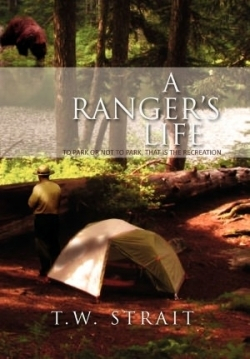A Ranger's Life
To Park or Not to Park, That is the Recreation
Few people who camp in public parks pause to consider the complexities involved in maintaining these facilities. Vacationers flock to scenic spots throughout the United States every day, in all kinds of weather, leaving stress-filled lives behind to relax in nature’s ambiance. Unless the toilets don’t work, noisy neighbors infringe on their privacy, or a serious emergency occurs, enjoying themselves remains foremost in their minds.
In A Ranger’s Life: To Park or Not to Park, That is the Recreation, T.W. Strait draws on experiences as a summer employee at the Lake Ozark State Park in Missouri*.* The first-person narrative takes place in 1999, when Jack Anderson, age thirty-one, begins his tenure as park superintendent of Osage State Park, in the Missouri Ozarks. Over a two-year period, Jack and his co-workers strive to develop an efficiently run facility despite squabbling campers, wandering wildlife, forest and boat fires, and several tragic accidents. Concurrently, his personal life evolves to include new friendships with other park employees and the rescue of a lost young woman who becomes more than just another camper to him.
Unpredictable weather often compromises the comfort of park visitors. Heavy rain, lightning, and thunder also serve to alert park workers to potential problems, such as wind or water encroaching on camp sites. Strait explains, “Sometimes when storms come unexpectedly and with some gusto, campers, in less than soundly built tents or trailers get themselves into trouble.”
When serious accidents happen, park personnel work cooperatively with the local sheriff’s office and conservation department. In one instance, Jack and his crew search for a private airplane that had reported ice on its wings and might be within the park’s boundaries. After locating the downed plane, they find the pilot dead near the crash scene and his passenger wandering around with a head injury. “This was a gruesome sight to behold; one that I’m sure won’t be forgotten by anyone present,” Jack says.
He learns that first impressions don’t always hold true when a man calls to reserve camp space for his motorcycle club. “Mid Mo Joe” sounds “on the seedy side,” but park policy prohibits discrimination so Jack assigns him a campsite. Upon arrival, the motorcyclists’ polite behavior surprises him. “I was really ashamed of myself for prejudging the group, simply from the name and idea of bikers.”
The interesting events Strait recalls in this book are overshadowed by his detailed descriptions of facility layouts and the procedures and supplies required to accomplish jobs. In addition, character development lacks the detail necessary to create a lively story for readers. Jack’s view of life seems to reflect that of a man Strait’s age rather than the attitudes of a thirty-one-year old in 1999. Misspelled words, punctuation errors, and tense shifts occur throughout the book, adding to the sense of a hastily written and edited text.
Nevertheless, people interested in an overview of how public parks operate, as told sincerely by an insider, will enjoy this book.
Reviewed by
Margaret Cullison
Disclosure: This article is not an endorsement, but a review. The publisher of this book provided free copies of the book and paid a small fee to have their book reviewed by a professional reviewer. Foreword Reviews and Clarion Reviews make no guarantee that the publisher will receive a positive review. Foreword Magazine, Inc. is disclosing this in accordance with the Federal Trade Commission’s 16 CFR, Part 255.

